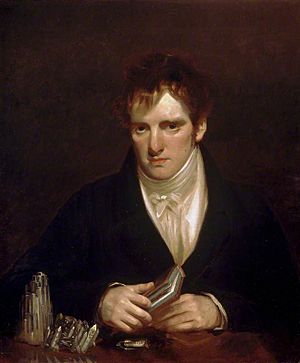Thomas Allan (mineralogist) facts for kids
Quick facts for kids
Thomas Allan
|
|
|---|---|

Portrait of Thomas Allan by John Watson Gordon, c.1824
|
|
| Born | July 17, 1777 |
| Died | September 12, 1833 (aged 56) Linden Hall at Morpeth, Northumberland, England
|
| Burial place | St Cuthbert's Church, Edinburgh |
| Occupation | mineralogist |
Thomas Allan (born July 17, 1777 – died September 12, 1833) was a British scientist. He was known for his work studying minerals. He was a member of important scientific groups like the Royal Society of London and the Royal Society of Edinburgh.
Contents
A Life of Minerals
Thomas Allan was born in Edinburgh, Scotland, on July 17, 1777. His father, Robert Allan, was a banker. Thomas went to the High School of Edinburgh. He also worked in banking, but he is best known for his work with minerals.
Collecting Minerals
From a young age, Thomas Allan loved minerals. He started collecting many different types of them. His collection grew very large! Later, he gave this amazing collection to his son, Robert Allan. Eventually, this collection became part of the British Museum of Natural History.
Helping Other Scientists
In 1813, Allan helped a German mineralogist named Karl Ludwig Giesecke get a job. This job was at the Dublin Philosophical Society, where Giesecke could continue his work with minerals.
Allan was chosen to be a member of the Royal Society of Edinburgh in 1805. This is a very respected group of scientists. He also became a member of the Royal Society of London in 1815. He helped lead the Royal Society of Edinburgh for many years.
A Mineral Named After Him
Thomas Allan's work was so important that a new mineral was named after him! In 1810, a mineral found in Greenland was called "Allanite" by scientist Thomas Thomson. This was a great honor for Allan's contributions to mineral science.
Later Life and Death
In his later years, Thomas Allan lived at 11 Royal Exchange in Edinburgh. He passed away on September 12, 1833, at Linden Hall in Morpeth, Northumberland, England. He was buried in St Cuthberts Churchyard in Edinburgh. His son, Robert Allan, also became a mineralogist, following in his father's footsteps.
What He Wrote
Thomas Allan wrote about minerals for important books. He wrote the article about "Diamond" for the fifth edition of the Encyclopædia Britannica. He also created a helpful list of mineral names. This book was called An Alphabetical List of the Names of Minerals, at Present Most Familiar in the English, French, and German Languages, with Tables of Analyses. It was first published in 1805 and had new, bigger versions in later years.

